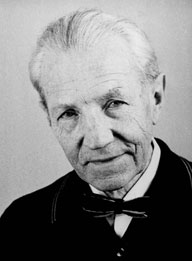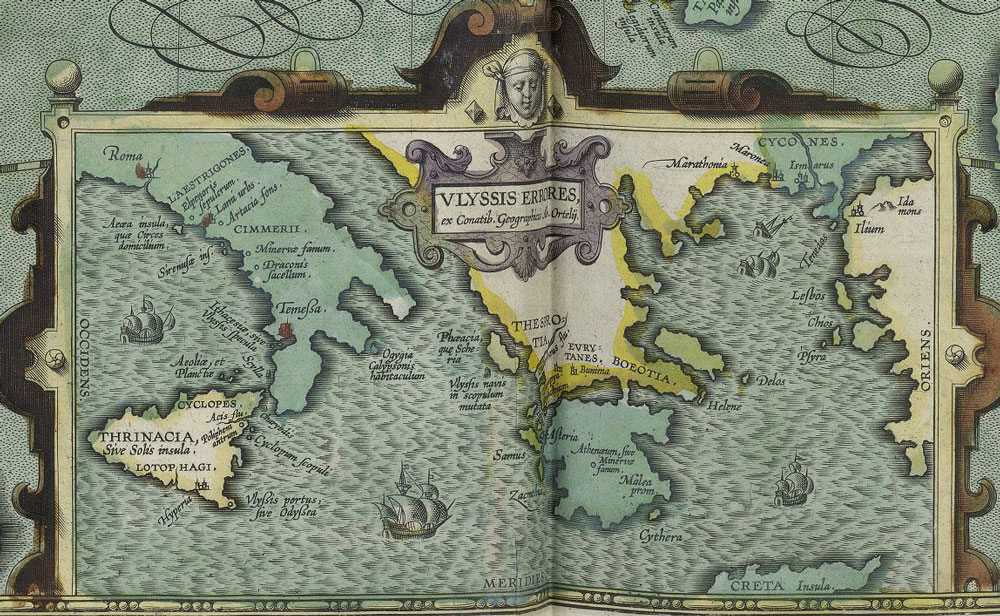Continental Drift
Expanding Earth Hypothesis *
The Expanding Earth Hypothesis.
For thousands of years, it was accepted that the surface of the earth was in a static state. This belief persisted until the rediscovery of America in 1492 and the cartographic improvements during the following century before Abraham Ortelius in his 1596 Thesaurus Geographicus[1225] proposed that the Americas had once been joined to Europe and Africa. It is often claimed that in 1620 Francis Bacon commented on the close fit of eastern South America with the west coast of Africa, however, this, according to G.L. Herries Davies, is an exaggerated interpretation of what he actually said(o).
A number of others concurred with the jig-saw suggestion until 1858 when the French geographer Antonio Snider-Pellegrini offered[0555] a theory of crustal movement that was more fully developed in 1912 by Alfred Wegener, which he came to label ‘continental drift’(e). Snider-Pellegrini also thought that the Earth had been much smaller at the time of the biblical Genesis(ac)! The big objection to the theory was a lack of a convincing mechanism to explain it(f).
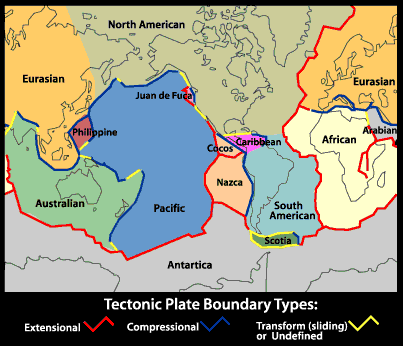 A number of writers have attempted to bring the theory of Continental Drift (CD) into the Atlantis debate. They seem to overlook the fact CD was proposed as a very very slow process, while Plato describes the demise of Atlantis as occurring in a single day and a night.
A number of writers have attempted to bring the theory of Continental Drift (CD) into the Atlantis debate. They seem to overlook the fact CD was proposed as a very very slow process, while Plato describes the demise of Atlantis as occurring in a single day and a night.
Wegener’s theory was debated until the late 1950’s when it morphed into the theory of Plate Tectonics (PT) following new developments in earth sciences in particular the recognition of seafloor spreading at mid-ocean ridges. However, PT as we know it demands subduction(z), which in itself has created new problems(aa)(ab).
The theory divides the lithosphere into a number of plates that are constantly moving in various directions at rates of a few centimetres a year. Competing with PT in the early years was the theory of Earth Crustal Displacement advocated by Charles Hapgood which claims that the entire crust of the earth moved as a unit. Endorsed by Albert Einstein it is fundamental to the theory of an Antarctic location for Atlantis proposed by Rose & Rand Flem-Ath.
Unfortunately, Plate Tectonics does not explain everything and ever since it gained the pre-eminence it currently enjoys, various writers have questioned what they perceive as its shortcomings(g)(h)(i).
A totally different proposal is that the earth is expanding. Although the concept did not get much attention until the 1980’s there are antecedents stretching back to 1888(a), when the earliest suggestion was made by the Russian, Ivan Yarkovsky (1844-1902). A year later the Italian geologist (and violinist) Roberto Montovani (1854-1933) proposed(I) a similar mechanism. In 1933, Ott Christoph
Hilgenberg(t) published Vom wachsenden Erdbal (The Expanding Earth) [1328].
In 1963, a Russian lady, Kamilla Abaturova, wrote to Egerton Sykes expressing the view that although her theory of an expanding Earth involved a ‘slow’ process, she proposed that at the time of Atlantis’ the radius of the Earth was 600 km shorter(af). In geological terms, this is far from ‘slow’!
The leading proponent of the theory today is arguably the, now retired, geologist Dr James Maxlow(b). A detailed outline of the theory is also offered on his website(c). For laymen like myself, a series of YouTube clips(d) are probably more informative. I have stated elsewhere that I am sympathetic towards the idea of earth expansion finding it somewhat more credible than plate tectonics. The truth of the matter is that since Ortelius first suggested that the continents of our planet had moved, all that has emerged since is a refinement of that basic idea leading to CD which became PT and as the latter still does not answer all the questions it raises, it is clear that further modification will be required. In December 2021, Maxlow published an overview of his current thinking on Expansion Tectonics(ag).
The Expanding Earth Hypothesis may, as its proponents claim, supply all those answers. Others do not think so, which brings me to J. Marvin Herndon who has ‘married’ the theory of an expanding earth with the idea of crustal plates(j) , naming his 2005 concept Whole-Earth Decompression Dynamics (WEDD).
The Thunderbolts.info website has a three-part article seeking to offer “an alternative to plate and extension tectonics”. The anonymous author suggests that an electrical element is involved in the development of our planet. An extensive look at mountain building is also included(y).
A 1998 paper(ah). by Bill Mundy an American Professor of Physics is still relevant. In it, he discusses the pros and cons of both plate tectonics and the expanding earth hypothesis and concluded that “Despite the success that standard plate-tectonics theory has enjoyed, there are phenomena that it currently is not able to model. Perhaps the most adequate model would incorporate Owens’ suggestion that there is both subduction and expansion. This would allow the earth to expand at a modest rate with reasonable changes in surface gravitation and also require some subduction for which the evidence seems convincing. But such a model presents the difficulty of finding suitable mechanisms for expansion, plate motion and subduction!”
In October 2022 Doug Fisher published a paper on Graham Hancock’s website highlighting weaknesses in the generally accepted theory of plate tectonics and seeking a review of the expanding earth hypothesis(ai).
Keith Wilson, an American researcher, has also developed a website(k) devoted to the EEH and linked it to Pole Shift. However, he goes further and introduces Mayan prophecies into the subject, which in my view is unwise in the light of recent events or rather non-events!
In the meanwhile, a number of Atlantis researchers have endorsed the EEH including, Stan Deyo, Georg Lohle and Rosario Vieni. Nicolai Zhirov referred to the growing support both in Russia and elsewhere for the EEH citing a number of its supporters, adding that “the idea of the Earth expanding (within reasonable limits) cannot be ruled out altogether as absurd.”[458.126]
A number of websites have dismissed the EEH as pseudoscience, which is confirmed by satellite measurements(m)(n).
There is also a variation of the standard expansion theory which proposes(q) that expansion may have occurred in fits and starts. There also seems to be evidence that the Earth is not alone with Venus expanding(r) and Mercury contracting(s).
Another matter that may be related to the claim of an expanding Earth is the question of the size of dinosaurs and other creatures and plants millions of years ago, which is claimed to have been impossible if gravity then was the same as today. A book[1218] by Stephen Hurrell has expanded on this idea. There is an interesting website(p) that deals with the enormous size of the dinosaurs as well as other creatures at the same period and the support it may offer the EEH.
Neal Adams, a respected graphic artist(u), is a vocal supporter of the EEH(v), but, he has gone further and has also proposed a growing Moon as well(w). Not content with that, he has extended his expansion investigations to other bodies in our Solar System, such as, Mars, Ganymede & Europa(x). Adams considers the term “Expanding Earth” a misnomer and has named his proposed expansion process ‘pair production’.(ad)
A December 2018 paper by Degezelle Marvin offers some new support for the EEH(ae). The author includes an interesting comparison of the problems of the currently accepted paradigm of plate tectonics with possible solutions offered by EEH. The author concludes with;
“The problems with plate tectonics were presented in this paper. Earth scientists dogmatically follow the plate tectonics theory that is falsified by geological data while Earth expansion is clearly a viable candidate to replace plate tectonics. Analysis map of the age of the oceanic lithosphere showed that the isochrons only ft on a smaller Earth with a calculated radius. Mountain formation has even been presented as a logical result of the Earth’s expansion. The average rate of the growth of the Earth’s radius is 1.22cm/year, obtained by geological methods.”
Finally, I cannot help thinking about those Victorians who thought that they had reached the pinnacle of scientific understanding. They were wrong and, I believe, that so are we, although we are slowly, very slowly, edging towards the truth, which may or may not involve the vindication of the Expanding Earth Hypothesis.
(a) https://www.checktheevidence.co.uk/cms/index.php?option=com_content&task=view&id=394&Itemid=59
(b) https://www.expansiontectonics.com/page2.html
(c) https://www.expansiontectonics.com/page3.html
(d) https://www.youtube.com/watch?v=OUkEu6YYR3s
(e) https://en.wikipedia.org/wiki/Continental_drift
(f) https://www.scientus.org/Wegener-Continental-Drift.html
(g) https://davidpratt.info/ncgt-jse.htm
(h) https://davidpratt.info/lowman.htm
(i) https://www.newgeology.us/presentation21.html
(j) https://web.archive.org/web/20200926204322/http://nuclearplanet.com/
(l) https://en.wikipedia.org/wiki/Roberto_Mantovani
(n) https://blogs.scientificamerican.com/history-of-geology/2014/05/12/the-expanding-earth/
(o) Francis Bacon and Continental Drift (archive.org) *
(p) The Inflating Earth: 4 – Gravity | MalagaBay (archive.org)
(q) https://web.archive.org/web/20161203151134/http://www.xearththeory.com/expansion/
(r) https://web.archive.org/web/20200808000231/https://www.xearththeory.com/expanding-venus/
(s) https://web.archive.org/web/20200807234839/https://www.xearththeory.com/mercury/
(u) https://en.wikipedia.org/wiki/Neal_Adams
(v) https://www.naturalphilosophy.org/site/dehilster/2014/09/22/is-the-earth-expanding-and-even-growing/
(w) Neal Adams: 02 – The Growing Moon | MalagaBay (archive.org)
(x) https://www.youtube.com/watch?v=zy3_sWF7tv4
(y) https://www.thunderbolts.info/forum/phpBB3/viewtopic.php?f=4&t=16534 (link broken Oct. 2019) See: https://atlantipedia.ie/samples/archive-3326/
(z) https://www.thoughtco.com/what-is-subduction-3892831
(aa) https://www.newgeology.us/presentation8.html
(ac) https://www.annalsofgeophysics.eu/index.php/annals/article/view/4622
(ad) https://malagabay.wordpress.com/2015/12/17/neal-adams-01-the-growing-earth/
(ae) https://www.gsjournal.net/Science-Journals/Research%20Papers-Astrophysics/Download/7531
(af) Atlantis, Volume 16, No. 1, February 1963.
(ag) NCGTJV9N4_Pub.pdf (registeredsite.com)
(ah) https://www.grisda.org/assets/public/publications/origins/15053.pdf
(ai) Maps, Myths & Paradigms – Graham Hancock Official Website
Termier, Pierre
Pierre Termier (1859-1930) was a French geologist who analysed basaltic lava dredged up from the Atlantic seafloor 500 miles north of the Azores in 1898. Termier was confused 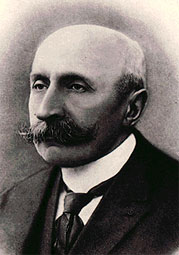 when he found that the sample was vitreous rather than crystalline. This had to mean that the water had been submerged after cooling. Since lava disintegrates after 15,000 years Termier was forced to conclude that there had been volcanic activity above sea level in the relatively recent past, perhaps coinciding with the destruction of Atlantis.
when he found that the sample was vitreous rather than crystalline. This had to mean that the water had been submerged after cooling. Since lava disintegrates after 15,000 years Termier was forced to conclude that there had been volcanic activity above sea level in the relatively recent past, perhaps coinciding with the destruction of Atlantis.
In 1912 Termier delivered a lecture[574] to the Institut Océanographique(b) in which he outlined his belief that Atlantis had been located in the Atlantic, a machine translation in English is available here as Archive 3667. A brief 9-page article by Termier, entitled New Light on the Lost Atlantis, has been reprinted by Kessinger Publishing. Termier also addressed the Smithsonian Institute who published his text in their 1915 annual.
In January 1917 a firm rebuttal of Termier’s ideas was written by Charles Schuchert of Yale University and published in Geographical Review,*however, the journal also published a favourable review by Rudolph Schuller in the same edition(a).*
In 1924 Termier he published La Derive des Continents, a paper in which he rejected Wegener’s theory of ‘Continental Drift’ as fanciful.
Although Termier’s claims are still quoted by some as factual, their scientific basis has been gravely undermined long ago, further weakening the case for Atlantis in the Atlantic.
*(a) https://www.jstor.org/stable/207366?seq=6#metadata_info_tab_contents*
(b) https://fr.wikisource.org/wiki/L%E2%80%99Atlantide_(Pierre_Termier) (French)
Snider-Pellegrini, Antonio
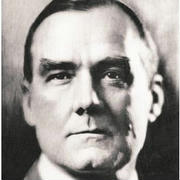 Antonio Snider–Pellegrini (1802-1885), was a French geographer, who, in 1858[555], offered a theory(a) that has been seen as a precursor to that of Alfred Wegner’s concept of Continental Drift, which developed into today’s widely accepted model of plate tectonics. It also appears that he,>along with Roberto Montovani(c),<thought that the Earth had been much smaller at the time of the biblical Genesis(c), anticipating the Expanding Earth Hypothesis!
Antonio Snider–Pellegrini (1802-1885), was a French geographer, who, in 1858[555], offered a theory(a) that has been seen as a precursor to that of Alfred Wegner’s concept of Continental Drift, which developed into today’s widely accepted model of plate tectonics. It also appears that he,>along with Roberto Montovani(c),<thought that the Earth had been much smaller at the time of the biblical Genesis(c), anticipating the Expanding Earth Hypothesis!
>Snider-Pellegrini published his theories in La Création et ses mystères dévoilés[555], where he is credited with creating the first representation of the Americas joined to Europe and Africa. This is shown below with the ‘before’ image marked ‘Atlantide’ where Brazil is.<
However, it is claimed that as early as 1620, Francis Bacon was one of the first to note the close fit between eastern South America and the west coast of Africa. Half a century ago, this attribution was heavily criticised by G. L. Herries Davies(b), who claimed that the idea came from a ”careless reading of the text.”
Snider-Pellegrini also added the suggestion that Brazil had been the location of Atlantis.
(a) https://web.archive.org/web/20200913123630/https://www.xearththeory.com/
(b) https://www.researchgate.net/publication/238388608_Francis_Bacon_and_Continental_Drift
(c) https://www.annalsofgeophysics.eu/index.php/annals/article/view/4622
Ortelius, Abraham
 Abraham Ortelius (1527-1598) was a Flemish cartographer who produced the first modern atlas, Theatrum Orbis Terrarum[1226], which at the time was reputed to have been the most expensive book ever printed.
Abraham Ortelius (1527-1598) was a Flemish cartographer who produced the first modern atlas, Theatrum Orbis Terrarum[1226], which at the time was reputed to have been the most expensive book ever printed.
It is interesting that he included the mythical island of Hi-Brasil (Brasil) off the coast of Ireland as well as the equally mysterious Frisland (Frieslant). Both can be clearly seen on his map using the link below(a).
In 1596 Ortelius was struck by the possibility that America, Europe and Africa had at one time been joined together but had over time become separated, an idea expressed in his Thesaurus Geographicus[1225]. Ortelius also included a speculative southern landmass, Terra Australis, which he designated as a “land of parrots”.
In 1597, Ortelius was the first to map(d) the travels of Homer’s Odysseus, notably locating all his adventures in the Central and Eastern Mediterranean, which was probably just a reflection of the limits of Greek maritime knowledge at the time that the narrative originated!
Ortelius suggested that Atlantis had been located in North America but that they had separated in the very distant past! Before modern theories of Continental Drift and its successor, Plate Tectonics, the idea of landbridges between continents was popular as an explanation for the spread of animals and people around the world. Some suggested as an alternative, the existence of lost continents such as Atlantis in the Atlantic, which acted as a stepping-stone between the continents(c).
Four hundred years later Alfred Wegener incorporated some of Ortelius’ ideas into his theory of Continental Drift, which later led to the current theory of Plate Tectonics.
A purpose-built polar exploration ship, m.v. Ortelius, was named after the geographer.
Recently, Doug Fisher has drawn attention to the similarities between a 1592 map of South America by Ortelius and the well-known Kircher map of Atlantis(b).
(a) https://upload.wikimedia.org/wikipedia/commons/e/e2/OrteliusWorldMap1570.jpg
(b) https://atlantismaps.com/chapter_7.html (link broken Oct. 2018) New website in development. (https://www.copheetheory.com/)
(c) Wayback Machine (archive.org) *
(d) https://www.laphamsquarterly.org/roundtable/geography-odyssey
Malaise, Dr. René Edmond
Dr. René Malaise (1892-1978) was a Swedish entomologist, at the Riks Museum in Stockholm, who is famous for the invention of the ‘Malaise trap’ for collecting insect  specimens.
specimens.
He wrote[461] about the Mid-Atlantic Ridge and its connection with Atlantis. Malaise was dismissive of Alfred Wegener’s theories, preferring the idea of landbridges rather than continental drift as the explanation for the existence of matching flora and fauna on both sides of the Atlantic. This view was expressed in a 1972 booklet, Land-bridges or Continental Drift[1455].
>Malaise also wrote An Alternative to Continental Drift in 1972, in which he supported the idea of a large meteorite impacting the Earth to the extent of altering the planet’s geographical layout!(e) <
He supported the 1934 ‘constriction hypothesis’ of the paleozoologist, Nils H. Odhner, which attributed vertical crustal movement to ocean temperature change rather than isostasy.
He contended[462][463] that at least parts of the Ridge were exposed during the last Ice Age and that the fossilised remains of freshwater diatoms found submerged on the Mid-Atlantic Ridge are evidence that the exposed Ridge contained freshwater lakes(c). Malaise believed that the Azores are remnants of Atlantis.
Malaise was also convinced that Atlantis probably traded with Egyptian colonists in England, who were responsible for Stonehenge! (Sykes’ Atlantean Research, Oct/Nov 1949)
He has also argued in a 1973 booklet, Atlantis: A Verified Myth[464] that the similarity of arrowheads found on both sides of the Atlantic point to a common ancestry, possibly on an Atlantic Atlantis. He further suggested that Atlantis had an important trading centre at the mouth of the River Elbe.
>In 1948, Malaise published a three-part paper, Atlantis: The Atlantis Continent and its Submersion in Sykes’ Atlantean Research magazine.(d)<
In his 1951 offering, Atlantis en Geologisk Verklighet[461], he included a number of maps illustrating his contention that Atlantis was submerged over a long protracted period of time.
Malaise supported the idea that Plato was referring to lunar ‘years’ when he spoke of 9,000 years being the time between the war with Atlantis and Solon’s visit to Egypt. Malaise believed that Atlantis finally disappeared in the 13th/12th century BC.
Dale Drinnon offers an extensive review(a) of Malaise and his theories.
Malaise had ideas that may appear very dated today, but in the light of scientific knowledge of his day, his conclusions were as valid as any other. In the same way new ideas today, based on what we know now, will appear equally antiquated fifty years from now. Every age repeats the mistake of thinking that it has reached the pinnacle of scientific understanding.
The excellent Atlantisforschung.de website has a more comprehensive article on the work of Malaise(b).
(b) https://atlantisforschung.de/index.php?title=Dr._Ren%C3%A9_Malaise
(d) Atlantean Research Vol.1, Nos. 2,3 and 4, 1948.
>(e) Atlantis, Vol 25, No.2, Mar-April 1972<

